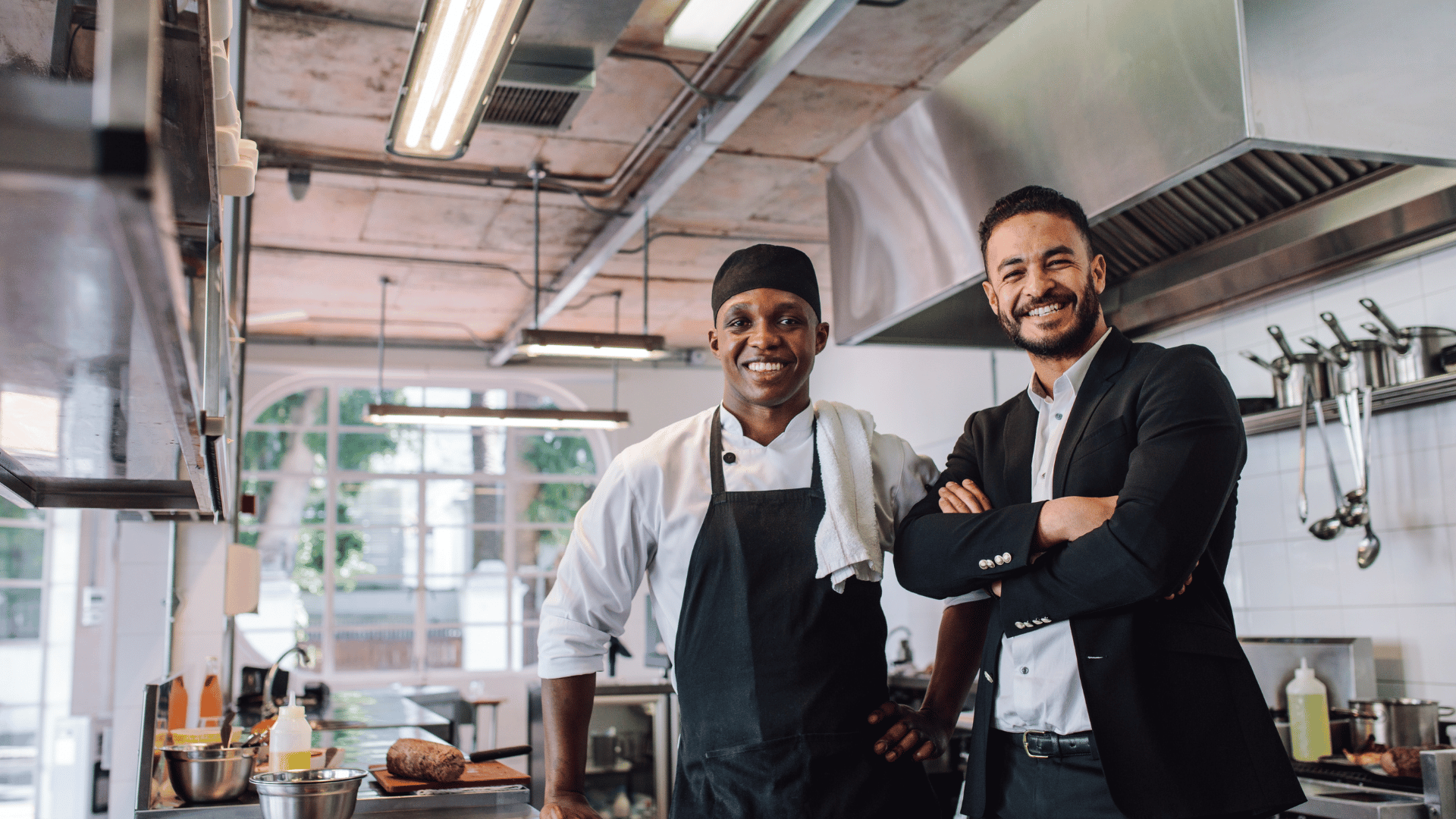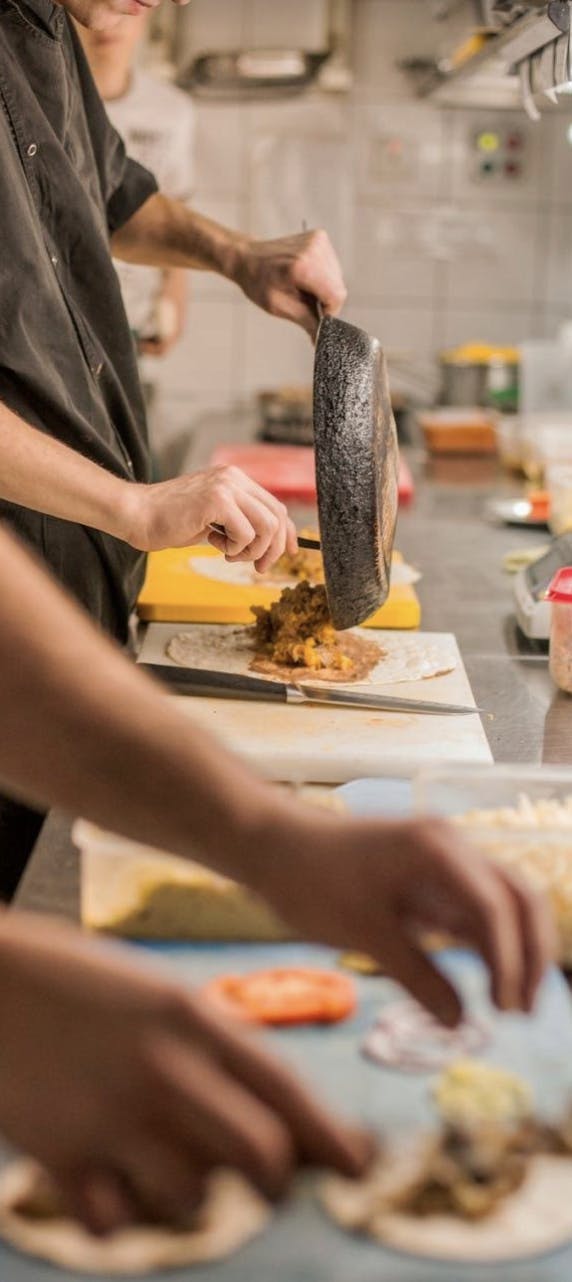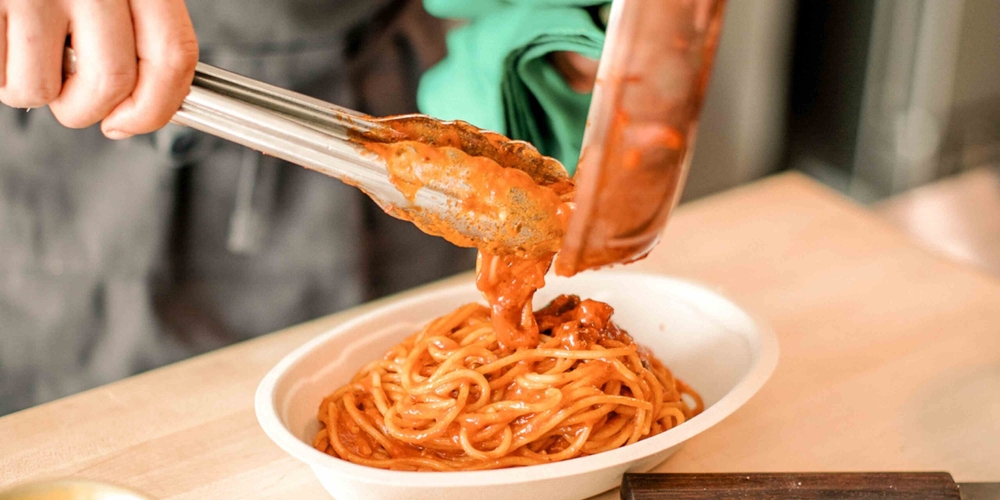The Ultimate Guide to Franchise Marketing
Table of Contents
CloudKitchens
How many tacos can be delivered from a 1000sqft restaurant?
The same amount as a 200sqft ghost kitchen.

“Who needs marketing when you’re a franchise?”
This question often pops up among franchisees who already possess the power of brand name recognition and contribute 3%–5% of their monthly gross revenue towards the franchisor-led national marketing campaigns. At this stage, it’s easy to fall into a complacency trap, assuming that the marketing aspect of the business is a given.
But this notion couldn’t be further from the truth.
While an established brand name and national marketing efforts offer a firm foundation, franchise marketing goes far beyond these elements. A strong local marketing strategy, in particular, can be a total game-changer, helping you gain traction in the local communities, drive business growth, and foster customer brand loyalty.
So let’s take a brief pause from the hustle and bustle of daily operations to unravel the secrets of successful franchise marketing.
What is Franchise Marketing?
Think of Franchise Marketing as a win-win partnership with a dual focus. At the corporate level (Franchisor), the job is to build brand strength (branding) and, of course, attract new partners (franchisee lead generation). It’s about showing why your food brand is a solid investment.
At the local level (Franchisee), the focus is hands-on: how to fill your location with orders! This means running sharp hyper-local campaigns, utilizing local SEO, and executing promotions that work in your neighborhood.
The big challenge is maintaining brand consistency, customers must have the same great experience whether they order in New York or Los Angeles. By effectively coordinating digital marketing, menu engineering, and delivery strategies, we ensure seamless territorial expansion and sustainable growth for the entire network.
What is the Importance of Franchise Marketing?
Franchise Marketing is essential for the entire network’s success.
For the Franchisee
Your biggest advantage is immediate structure and credibility. You drastically reduce risk and Customer Acquisition Cost (CAC) because you use pre-tested digital marketing campaigns developed by the corporate office.
This standardization ensures customer experience uniformity, meaning your customers know what to expect, which drives loyalty and results in great online reviews. Centralized marketing serves as your local SEO and promotional roadmap, allowing you to focus on your unit’s regional presence and sales.
For the Network
The Franchisor uses marketing to maintain brand coherence and sustain territorial expansion. A well-structured system allows the corporate office to control brand image, gather strategic consumer data, and drive product development.
This means the brand is constantly being strengthened and attracting more high-caliber franchisees, which, in turn, increases the value and recognition of your own unit in the market.
Enterprise franchising vs local chains
Before we dive into the following marketing tips, a caveat is in order: the applicability of certain strategies depends largely on your specific circumstances.
Franchising is an all-encompassing term that can encapsulate various scenarios, ranging from nationally renowned brands like Chick-fil-A to local pizza chains with a handful of locations within a specific county or region. As such, the degree of control and the scope for marketing strategies vary significantly between the two, shaping unique challenges and opportunities.
Enterprise franchising
When you’re part of an enterprise franchise, you benefit from a well-established brand presence and substantial marketing resources—to which you contribute a monthly fee. The largest food franchises in the US include:
- McDonald’s
- Taco Bell
- Subway
- Chick-fil-A
- R&L Foods (Pizza Hut)
- Panera Bread
- Wendy’s
- Popeyes
- Denny’s
- Burger King
These brands typically enforce strict guidelines on brand representation and marketing, limiting individual franchisees’ ability to express their unique identity. This precaution prevents any rogue franchisee from harming the overall public perception of the brand.
Typically, with this arrangement, the franchisor handles the national advertising campaigns. So, as a franchisee within this system, you’re mostly relieved from broader brand marketing responsibilities. Your role primarily lies in aligning with the franchisor’s overarching marketing strategy and emphasizing local-level marketing.
Local chains
Conversely, if you’re the franchisor or franchisee of a local chain or regional franchise, you may be granted a greater degree of marketing autonomy. With less stringent brand guidelines and a smaller marketing fund, franchisees are usually expected to take up the initiative in promoting their individual locations.
Naturally, local chains have more freedom to engage in an array of traditional and digital marketing strategies. Therefore, much of the advice provided in this guide will be particularly relevant to franchises within this group.
What are the Types of Franchise Marketing?
Franchise Marketing is split into two types, and you benefit directly from both:
Operational Franchise Marketing (Your Focus)
This is your daily priority, focused on local customer attraction and retention. The goal is to strengthen your regional presence and drive immediate sales. Your tactics involve local SEO (optimizing your Google Business Profile), creating specific loyalty programs, and running hyper-local campaigns (like community event partnerships or influencer collaborations).
The franchisor gives you the flexibility to adapt promotions to your local audience, provided you maintain brand identity and branding guidelines. This execution turns brand awareness into profit for your unit.
Practical Example of Operational Franchise Marketing
Imagine you opened a Tropical Bowl (fictional brand for this example) unit in Austin, Texas. To boost sales, you use corporate guidelines to run a hyper-local campaign. Your “Austin Loves Açaí Week” offers a 20% discount code for customers who check-in and tag your store on Instagram.
Simultaneously, you execute a strategic B2B partnership with a local gym, handing out tasting coupons. These tactics drive both physical and digital local traffic, boosting community engagement and optimizing your local SEO through tags and mentions.
You achieve immediate sales, adhere to the corporate visual standard, and efficiently increase your regional presence.
Development Franchise Marketing (Corporate Focus)
This is the franchisor’s job: to expand the network and consolidate the brand nationally. They invest in brand awareness campaigns, PR, and performance marketing to attract high-quality new franchisees.
For you, the benefit is indirect but vital: the stronger and more recognized the brand is nationally, the greater your immediate market credibility. This simplifies your operational marketing efforts and increases the perceived value of your unit.
Practical Example of Development Franchise Marketing
The Tropical Bowl franchisor launches the national campaign “Be Part of the Bowl Revolution,” focused on territorial expansion. They invest in institutional advertising (like successful franchisee stories) and performance marketing ads on LinkedIn, targeting investors.
They also attend events like the Franchise Expo South. What does this mean for you? Every campaign increases national brand awareness.
This directly benefits you because the stronger the brand becomes, and the more high-caliber entrepreneurs want to buy franchises, the more it raises the perceived value and immediate credibility of your own unit in Austin.
3 Essential Tips for Your Franchise Digital Marketing Plan
There’s little doubt that social media has transformed the way food and beverage businesses reach out to their audiences. For both local and national franchises, these platforms make it possible to:
- Connect with consumers
- Build brand loyalty
- Engage in targeted advertising
- Receive real-time customer feedback
- Promote new products and offerings
- Drive revenue
That said, franchisors must strike a delicate balance. They need to maintain brand identity and integrity while empowering franchisees to engage with customers and share relevant content.
Social media can be a double-edged sword. Although it may be tempting for franchisors to allow franchisees the freedom to control and grow their location’s social presence, all it takes is a single instance of poor social media management to potentially tarnish the entire brand’s reputation.
Therefore, when it comes to socials, if franchisees are given autonomy, the franchisors should first establish clear social media policies that provide a framework for franchisees to create content, engage with customers, and manage their online presence.
Tips include:
- Establish workflows: Decide the exact social media workflow between the franchisor and franchisee, then determine whether or not to create separate social profiles for individual locations.
- Create a brand template: Provide franchisees with brand-approved templates for posts, guidance on responding to comments and reviews, and lists of do’s and don’ts for brand reputation management.
- Build consistency: The same branding elements, voice, and messaging should be present and consistent across all locations.
- Localize content: Although maintaining a consistent brand image is important, individual locations should personalize content to reflect the local community’s interests, events, and people.
- Promote user-generated content: Encourage customers to share their experience via pictures of their meals, reviews, or comments on service or food quality for authentic brand building.
1. Create a comprehensive content marketing strategy
Especially when it comes to local search, content marketing can be your ace in the hole. A well-planned and -executed strategy can boost local engagement, sales, and brand awareness.
Content marketing is an essential aspect of both search engine optimization and modern advertising. It’s the vehicle through which franchisors can deliver value to current and potential diners by sharing content that is engaging and informative, thereby fostering trust.
Unlike traditional franchise marketing tactics (which tend to be in your face “buy the food in our commercial”) content marketing is a more nuanced and organic route for cultivating brand loyalty.
What that looks like in practice will largely depend on your brand. Even so, it should include a range of content types, including written, visual, audio, social, and user-generated content.
To that end, keep the following tips in mind:
- Focus on localized blog posts to drive organic traffic to your website and Google My Business pages while improving local SEO.
- Perform local keyword research and incorporate that into your content efforts.
- As with social media, ensure that all content reflects the brand’s voice and values.
- Highlight the unique offerings that differentiate the franchise from other locations and competitors, such as unique menu items, events, or features of the location.
- Regularly update your website, blog page, social media channels, and Google My Business pages with fresh and regular content updates.
- Provide educational and value-add content like cooking tips, menu updates, or behind-the-scenes looks at the franchise.
- Be sure to optimize the on-page SEO.
2. Emphasize local SEO
As mentioned, local marketing and SEO are the key marketing areas to focus on. Ideally, you want to optimize your digital pages so that your franchise website will rank prominently in local search queries and Google Map searches.
Done effectively, this can land your business on Google’s “snack pack”—the top 3 organic business listings that appear before other search results and which provide a snapshot about the business, including:
- Location
- Hours of operation
- Contact details
- Reviews
To optimize local SEO, franchises should:
- Claim your Google My Business listing and set up a Business Yelp page: These are the platforms where you’ll share vital details about your business.
- Complete your Google My Business profile: Fill in all the fields accurately, including your address, contact information, and business category.
- Provide a keyword-rich business description: Include keywords that potential customers might use when searching for your products or services.
- Post high-quality photos: Images can greatly enhance your profile’s appeal, showcasing your location and food to potential customers.
- Specify your service area: Especially if your franchise delivers food, defining your service area can help you reach more customers.
- Collect and respond to reviews: Positive reviews can boost your business’s credibility and visibility. Make sure to respond to all reviews, showing that you value customer feedback.
3. Redesign your website
A website is a restaurant’s digital storefront. And, in today’s digital age, your online presence can be a deciding factor for potential diners who may be on the fence. It’s a place they can go to see reviews, check out the menu, learn more about location and hours of operation, and so on.
How do you create a top-notch restaurant website? Consider these tips:
- Showcase high-quality visuals of your food and restaurant.
- Provide all the essential information discussed above.
- Make sure the website is easy to navigate.
- Prioritize a user-friendly layout.
- Include an “About Us” page.
- Utilize a mobile responsive web design.
- Focus on search engine optimization.
- Offer online reservations and deliveries.
- Integrate Google My Business and Google Maps.
- Promote user reviews.
- Keep the website up-to-date.
- Include a contact form.
Explore ghost kitchens
Are you in the preliminary stages of the franchising process? Are you contemplating expansion to a new location?
If so, that doesn’t necessarily mean you need to go through the lengthy and burdensome process of establishing a brick-and-mortar franchise location. In the era of food delivery apps, franchising doesn’t have to be such a significant undertaking thanks to ghost kitchens.
Ghost kitchens are essentially commercial cooking spaces exclusively designed for preparing food for delivery, allowing you to completely bypass the necessity of a traditional dine-in space.
This innovative concept allows you to open up a “virtual franchise” in a new area while eliminating many of the financial burdens, logistical issues, and legal requirements associated with traditional brick-and-mortar establishments.
Since ghost kitchens rely heavily on food delivery apps, there’s less of a need to focus on the other aspects of marketing that are commonly associated with a physical franchise.
CloudKitchens: Your trusted ghost kitchen space
Interested in learning more about how ghost kitchens can accelerate and ease your franchise efforts?
At CloudKitchens, we’re reimagining what the modern restaurant looks like and is capable of. Our move-in ready facilities and dark kitchen software are expressly designed and optimized for food delivery services.
You focus on the marketing. Let us be the hub for all of your delivery services. (We think we’re going to make a great team.)
| DISCLAIMER: This information is provided for general informational purposes only and the content does not constitute an endorsement. CloudKitchens does not warrant the accuracy or completeness of any information, text, images/graphics, links, or other content contained within the blog content. We recommend that you consult with financial, legal, and business professionals for advice specific to your situation. |
Read more:
- What are the best food franchises? Check out the top 9
- How to measure the restaurant franchise success rate?
- Restaurant Franchise | CloudKitchens
- How to Franchise a Restaurant: Guide for Success
- What are the real costs of operating a franchise? A complete breakdown
Sources:
QSR Magazine. 10 Great Franchise Deals. https://www.qsrmagazine.com/franchising/10-great-franchise-deals
Franchise Times. Restaurant 200. https://www.franchisetimes.com/app/2022%20Franchise%20Times%20Restaurant%20200-WEB.pdf
Please note that this article is for informational purposes only and is not intended as tax, legal, HR, accounting, or other professional advice.
More insights & stories
There’s more where that came from.
Get in the know and check out our additional insights



